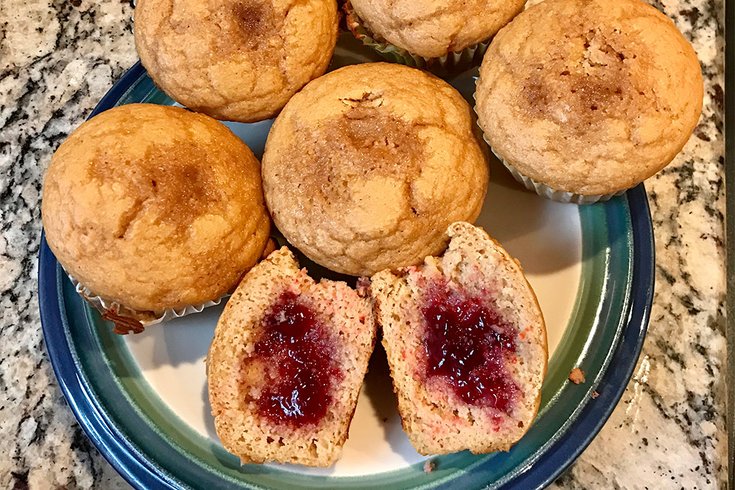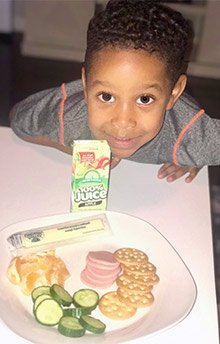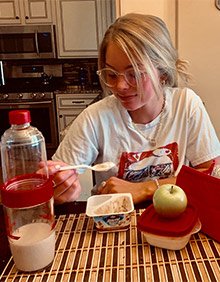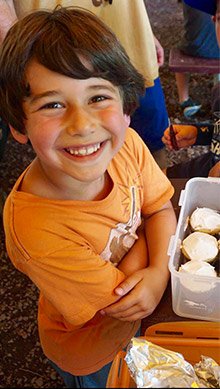
August 23, 2019
 Photo courtesy/Emily Rubin
Photo courtesy/Emily Rubin
Ultimate Muffins are free of nuts, wheat and gluten, soy and dairy.
What if a single bite of a cookie could make your child violently ill?
Food allergies and intolerances are a challenge that many families face as the grind of packing school lunches gets closer and closer.
It is estimated that 5.6 million children under age 18 have food allergies. That is about one in 13 children, or roughly two in every classroom. Moreover, about 40 percent of children with food allergies are allergic to more than one food.
Read on for the difference between a food allergy and intolerance, and ways to help your child stay safe during meal times this new school year.
A true food allergy occurs when your immune system overreacts to a food or a substance in a food, identifying it as a danger and triggering a protective response. It can cause a range of symptoms, including rashes, hives or itchy skin. In some cases, symptoms, such as shortness of breath and chest pain, can be severe or life-threatening. The eight major food allergens are milk, egg, peanut, tree nuts, wheat, soy, fish and crustacean shellfish. These have been responsible for most of the serious food allergy reactions in the United States. Sesame allergy is now becoming an emerging concern.
 Photo courtesy/Emily Rubin
Photo courtesy/Emily RubinAdrian, who has peanut and egg allergies, eats plenty of fruits and veggies.
As a nut alternative, I recommend to pack sunflower seed butter and jelly sandwiches. If you have a wheat allergy, use the multigrain versions of gluten-free bread, crackers or rice cakes. They will keep you feeling satisfied during the long school day.
A food intolerance refers to the body not properly digesting a particular food, possibly causing nausea, gas, cramps, abdominal pain, diarrhea, irritability, nervousness or headaches. If you have a food intolerance, you may be able to eat a small amount of the offending food without symptoms. If you have lactose intolerance, you may be able to drink lactose-free milk, eat hard cheese or even take lactase enzyme pills (such as Lactaid) to aid in digestion when consuming dairy products.
I suggest nondairy options to my patients with a lactose intolerance, such as nut milks and yogurts, which have come a long way in taste and flavor. These options contain the same amount of calcium and vitamin D as regular dairy products.
Alyssa, who is lactose intolerant, enjoys cashew milk and almond yogurt as part of her lunch.
Celiac disease is an autoimmune disease in which people cannot eat gluten – a protein found in wheat, rye and barley – because it will attack and damage their small intestine. It is estimated that one in 100 children have celiac disease, making it a common condition in children. While the symptoms are not immediately life-threatening, consuming gluten interferes with the absorption of nutrients from food. Continuous exposure to gluten can result in serious long-term health conditions, even for those who do not experience symptoms.
 Photo courtesy/Emily Rubin
Photo courtesy/Emily RubinAlyssa is lactose-intolerant. She enjoys cashew milk and almond yogurt as part of her lunch.
While many schools offer gluten-free menus, I remind all my patients, or parents of patients, that there is always a risk with cross contamination when the lunch is made outside the home and that packing is the only way to ensure the food is safe to consume. Kids are also known to trade lunches with friends in the cafeteria. Now swapping lunches must be forbidden and closely monitored.
Aden brings his own gluten-free cupcakes to school parties, an option I often recommend. For a gluten-free lunch, pack your favorite gluten-free pasta dish in a thermos. If looking for a great bread alternative, use a corn tortilla or gluten-free wrap and add your favorite fillings.
But these restrictive diets can be especially hard on children. They can often feel that they are missing milestone moments with their friends, such as eating pizza and cake at a classmate's birthday. Now, many schools do not allow outside food to be brought in for parties. It is an important conversation to have with the child's teacher.
• Educate your child. Make sure your child knows what foods they can and cannot eat. Discuss the signs of an allergic reaction, what to do and who to notify in the case of an allergic reaction. Remind them that there can be absolutely no sharing food, no matter how appetizing the food looks. Teach your child how to read food labels. Most importantly, learn and teach proper hand-washing techniques.
 Photo courtesy/Emily Rubin
Photo courtesy/Emily RubinAden, who has celiac disease, attends a school that offers a gluten-free menu.
• Collaborate with the school team: nurses, teachers and food service staff. Meet with the school staff about your child's dietary restrictions. Discuss the importance of preventing food sharing. Contact the school's food service staff to receive copies of the school menu in advance. This will help to identify the allergens in the food ahead of time.
The primary goal is to develop a plan to ensure that your child is healthy, nourished and safe in the school environment.
• • •
Ultimate Muffins are free of nuts, wheat and gluten, soy and dairy. They're also low in fat and sugar, as well as high in protein, fiber and calcium.
Servings: 12 muffins
2 cups whole-grain gluten-free waffle/pancake mix
2 eggs

Emily Rubin, R.D.
1 scoop (28g) vanilla pea protein powder
1 cup unsweetened applesauce
1 tsp baking powder
1/2 cup brown sugar
1 tsp cinnamon
Optional: 1 cup nuts, dried fruit, chocolate chips
• Preheat oven to 350 degrees.
• Spray muffin tray with non-stick spray (or use muffin cups).
• Mix all ingredients.
• Pour muffin cups to rim.
• Sprinkle cinnamon and brown sugar blend on top.
• Bake for about 15 minutes until golden brown and toothpick is clean from the middle of muffin.
Spread with a fruit preserve or nut-free butter, or enjoy 'em plain.
Emily Rubin, R.D., has been a registered dietitian with Thomas Jefferson’s division of gastroenterology and hepatology for 18 years. She is the dietitian for its celiac center, Fatty Liver Center and Weight Management Center. She is also the public relations chair for the Philadelphia Dietetic Association. She will be writing occasionally on topics related to nutrition and dieting.